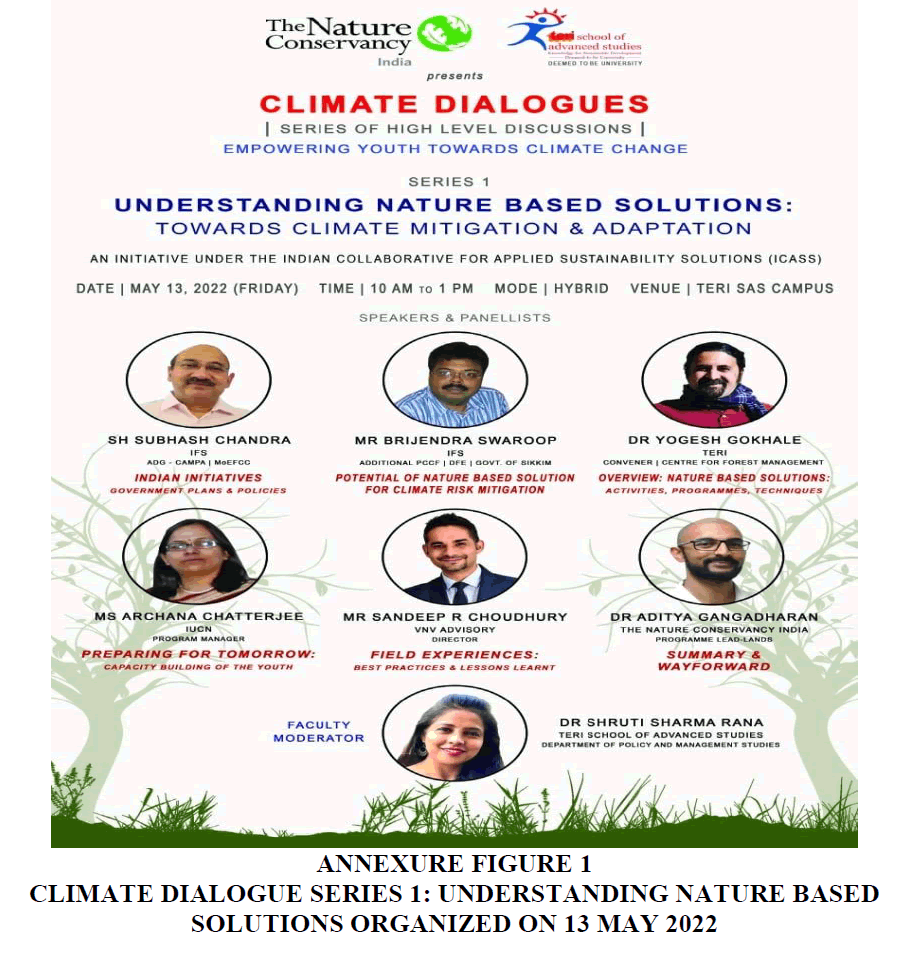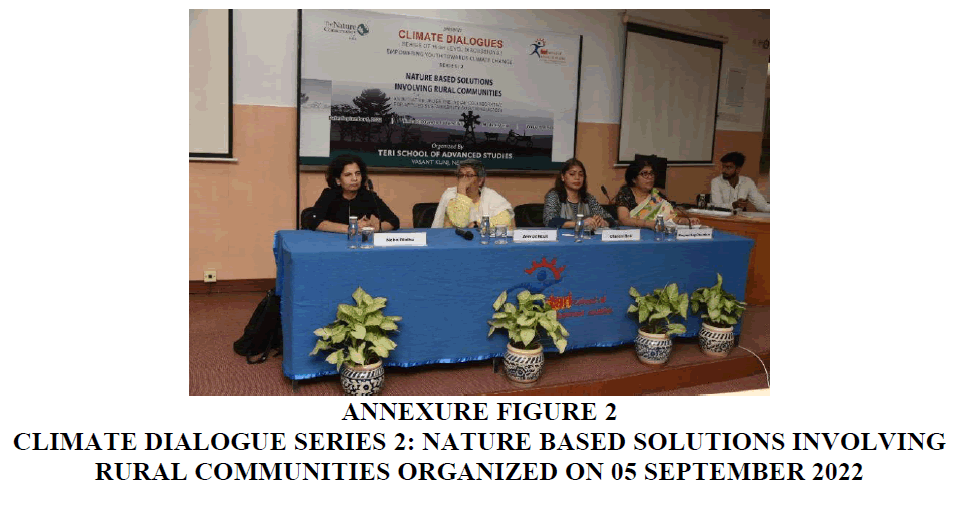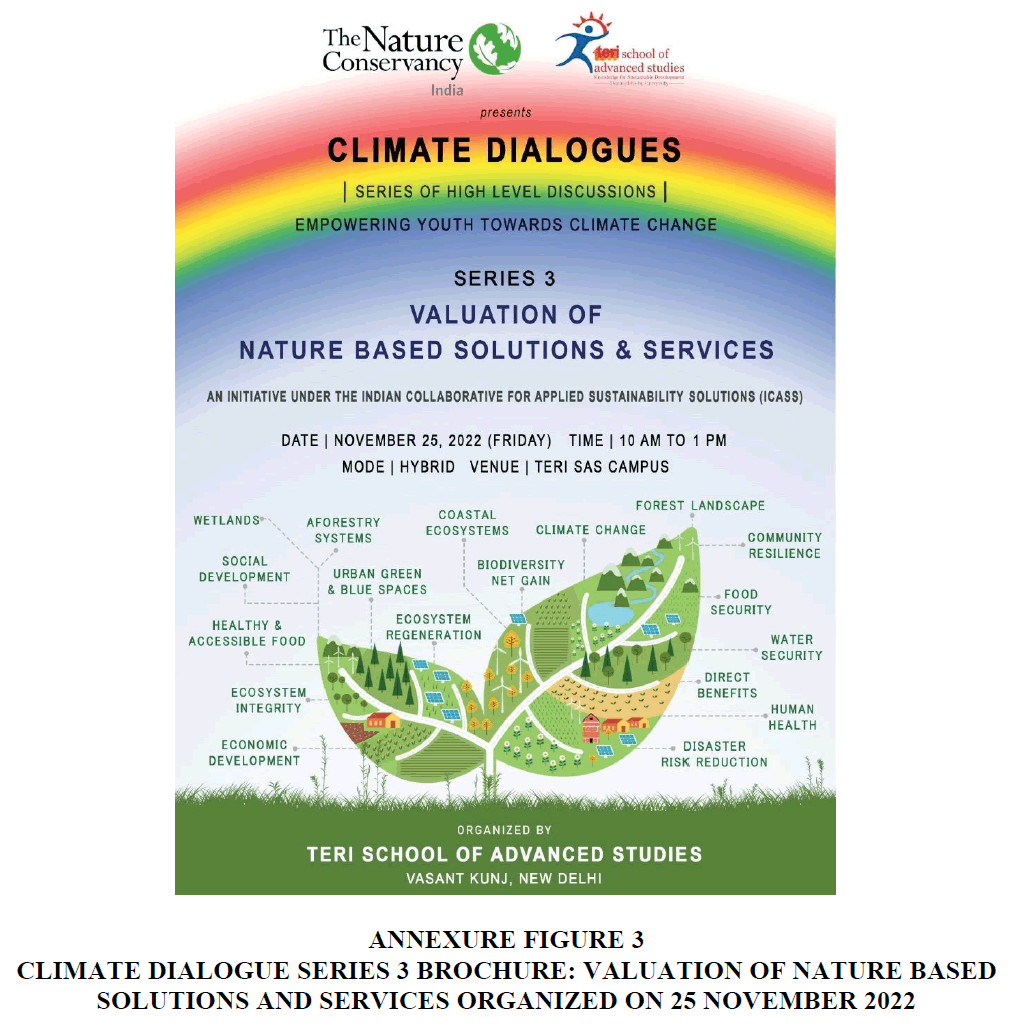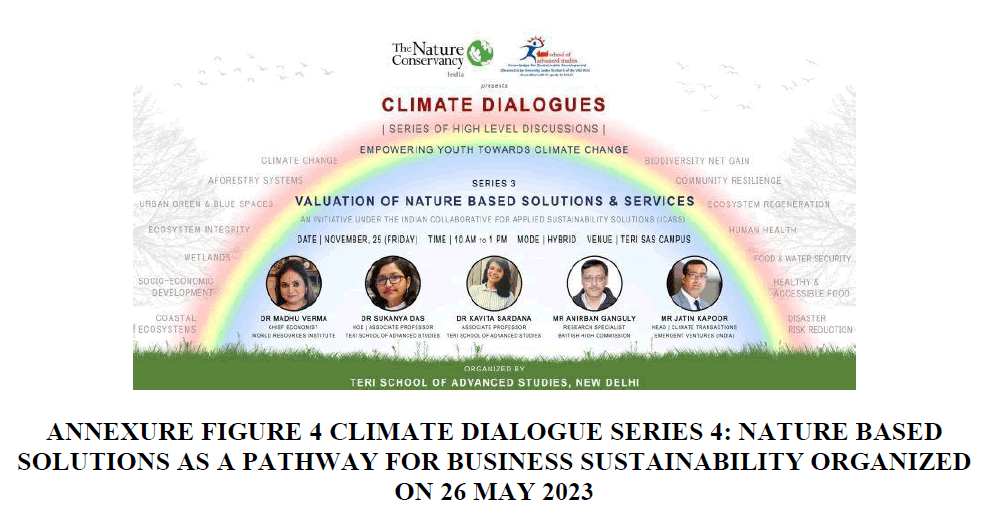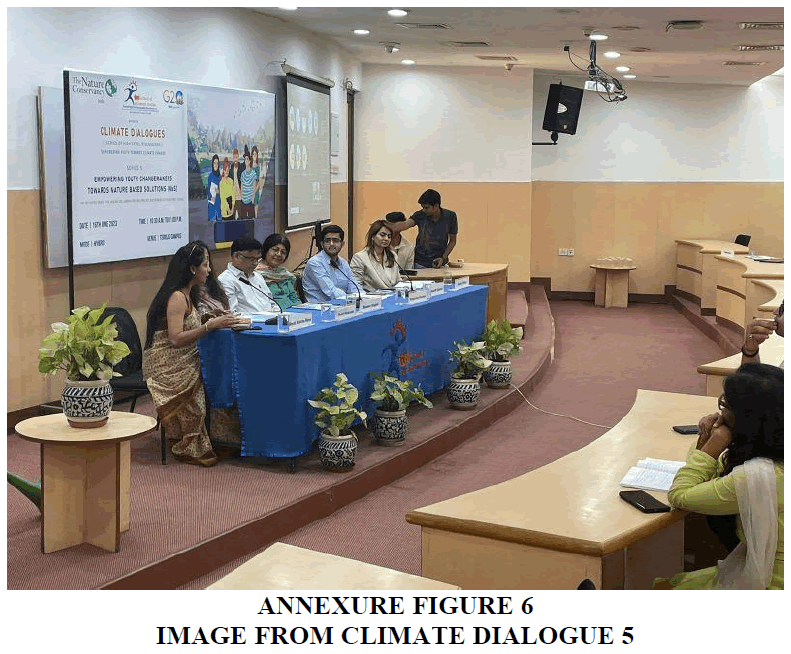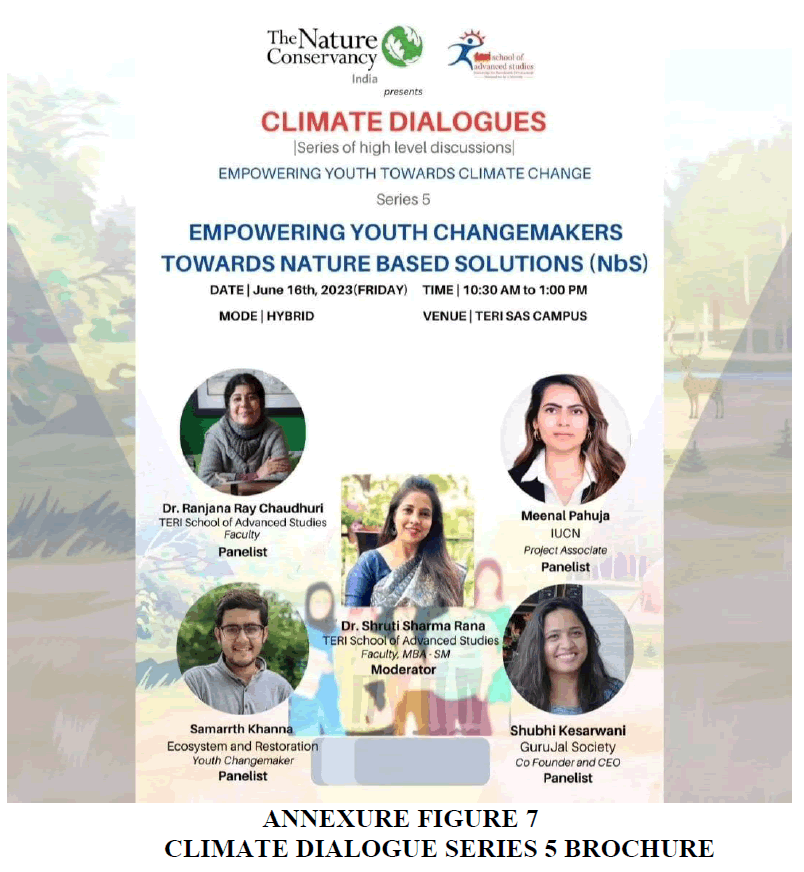Review Article: 2024 Vol: 28 Issue: 3
Challenges & Barriers for Nature Based Solutions for Indian Landscape
Shruti Sharma Rana, TERI School of Advanced Studies
Vedika Singh, TERI School of Advanced Studies
Citation Information: Sharma Rana, S., & Singh, V. (2024). Challenges & barriers for nature based solutions for indian landscape. Academy of Marketing Studies Journal, 28(3), 1-16.
Abstract
Nature based Solutions (NbS) plays a pivotal role in addressing complex environmental and socio-economic challenges. By adopting NbS in various domains of planning, adaptation and mitigation, the benefits of creating a harmonious balance between nature and development can be achieved for long term sustainability. The paper provides an overarching view on the potential challenges and barriers involved in the widescale adoption of NbS in India. Adopting NbS is a collective endeavor that requires the participation of all stakeholders including governments, private sector, academia and local communities. The present paper resulted from the collaborative co-production of knowledge, involving the participation of over 20 experts representing various stakeholders. These experts engaged in discussions with an audience of approximately 700 individuals during a five-part series of deliberations hosted at the TERI School of Advanced Studies in partnership with The Nature Conservancy India and The Collaborative for Applied Sustainability Solutions (ICASS). The white paper presents a list of recommendations that can be integrated in current development agenda to translate NbS concept into actionable strategies with emphasis on the need for establishing regulatory frameworks, funding strategies, financial mechanisms, stakeholder collaboration, data monitoring and evaluation along with addressing the need for equitable distribution of benefits. In conclusion, the paper provides a comprehensive roadmap for enhancing the adoption of quality NbS projects that would foster sustainable development, mitigate climate change and build overall resilience for the future along with co-benefiting all stakeholders including communities, businesses and governments.
Keywords
Nature based Solutions.
Introduction
Nature-based solutions are typically defined as “actions to protect, sustainably manage, and restore natural or modified ecosystems that address societal challenges effectively and adaptively, simultaneously providing human well-being and biodiversity benefits.” The overarching concept of NbS also includes other terminologies for similar solutions and approaches including ecosystem-based adaption (EbA), green infrastructure, natural climate solutions, ecological restoration, ecosystem services, green farming, urban greening, agroforestry etc. Nature based solution (NbS) has offered solutions in ecological restoration and resilience building through innovative engineering, infrastructure creation and integrated management of resources. NbS has offered answers to pertaining problems of climate change, land degradation, land, and water and air pollution. NbS not only enhances climate mitigation but also ensures regaining of lost ecosystems, having ripple socio-economic effects. IPCC notes that agriculture, forestry, and other land use accounted for 24% of GHG emissions and thus, NbS could help contribute 30% of world's mitigation potential. Co-benefits include restored ecosystem services, biodiversity conservation and sustainable livelihood development. Therefore, in addition to fulfilling the climate targets, NbS can help countries meet their SDGs within the stipulated timelines.
NbS has become a key strategy in ensuring creation of a circular economy where local solutions, cost effective strategies and resilience building is a central point. Creating NbS requires innovative strategies that link all stakeholders including communities, policy makers, researchers and businesses alike. NbS is a driver of sustainable living today, being widely integrated in infrastructure creation and Greenfield projects (Matthews et al., 2022). The paper represents the outcome of co-production of knowledge developed from a triangulation of firstly, a comprehensive review of literature; secondly, two-way interaction between stakeholders and audiences comprising of policy professionals, private sector experts, civil society, researchers, and students and finally, feedback collected from select panelists. The white paper deals with the ongoing challenges and barriers faced in enhancing largescale utilization of NbS. It provides a set of recommendations emerging from literature, stakeholder dialogues and expert feedback. The paper is significant for targeted problem solving, allocating resources, employing right tools and ensuring positive engagement of stakeholders in adoption of NbS. The white paper is beneficial to all stakeholders including policy makers and businesses for addressing economic viability for upscaling and replicating NbS projects across India whilst ensuring environmental and social benefits.
Objectives
The paper aims to achieve the following objectives:
1. Identify key challenges and barriers in adoption of NbS and its implementation in India, to discuss solutions in addressing these road blocks.
2. To provide a comprehensive repository of recommendations for widescale implementation and adoption of NbS that ensures economic, social and environmental viability.
3. To enable co-production of knowledge on NbS through diverse stakeholders’ participation and engagement for ensuring the seamless integration of NbS practices in Indian landscape.
Literature Review
The concept of nature based solution has been prominently discussed in literature in recent years as a strategy and tool for innovating solutions to ongoing challenges of ecosystem deterioration, climate change and biodiversity loss (Sheikholeslami & Murti, 2021). NbS emerged as a concept in 2008 by World bank NbS has become an essential part of sustainable development as it ensures that human activities are aligned for the benefit of nature and not against it IUCN, 2020). It makes communities more resilient and restores the natural balance of ecosystems (Sowińska-Świerkosz & García, 2022).
Nature based solutions offer a way of dealing with problems from natural surroundings with locally available material and sustainable solutions. In the process of applying NbS, ecological restoration and biodiversity promotion is also achieved. In due course of time, application of nature based solution has developed into a multidisciplinary domain, with linkages to economy, society and governance (Sowińska-Świerkosz & García, 2022). NbS has been widely used in a range of activities. Building new infrastructure, renovating existing buildings, creating disaster management plans and in adopting climate change techniques. NbS offers an innovative approach towards creating environmentally sustainable measures across the globe. It has widely been used as part of green infrastructure particularly hydrological projects. The successful implementation of NbS minimises economic, social and environmental costs (Vogelsang et al., 2023). IUCN defined NbS as “actions to protect, sustainably manage, and restore natural or modified ecosystems that address societal challenges effectively and adaptively, simultaneously providing human well-being and biodiversity benefits” IUCN, 2020. With development of the green circular economy, adoption of NbS in every sector and industry is imperative. Utilising NbS will ensure environmental conservation but also increase in social capacity building (Thematic Brief on Social Protection Nature-Based Solutions, 2020. NbS also ensures better public health and minimal waste generation. A circular economy is based on the model of minimum waste generation and sustainable use of natural resources through application of innovative knowledge, while offering inclusive development opportunities to all stakeholders. Hence it is necessary to include NbS as part of creating a circular economy (Sowińska-Świerkosz & García, 2022). NbS ensures rebuilding and restoration of natural capital. Using natural solutions for local problems promotes the development of local communities, creating a bottom-up approach to governance. NbS has proven to significantly improve the standard of living of communities. A key benefit of NbS is that it encourages adoption and inclusion of practices that are aligned in achieving Sustainable development goals, including water conservation, food production, waste management and biodiversity protection among others (Martín et al., 2020). As Greenfield projects are adopted, nature based solutions play a central role in developing projects for creation of sustainable living spaces (Nóblega-Carriquiry et al., 2023). NbS creates a space for the participation of different stakeholders enhancing the creation of transparency in governance and facilitating adaptive management. It offers businesses the opportunities to align their strategies to larger global sustainability goals. NbS is a wide domain which thrives on innovation and scientific research which offers academia the platform to drive new research and inventions that provide larger benefits to society and environment. Different models of NbS that are adopted require innovative policy tools and mechanisms creating openness for exchange of dialogues and deliberation and co-creation of knowledge among academia, industry and policy makers (Investing with Nature: Exploring Investment Opportunities Across Ecosystems, 2023; Mabon et al., 2022; Melanidis & Hagerman, 2022; Mguni et al., 2022; Snep et al., 2023).
Nature based solution is also an integration of local and traditional knowledge and skills with modern expertise. These ensure the protection of heritage practices pertaining to environmental protection. Another benefit of NbS is the promotion of cost-effective solutions and the adoption of green infrastructure (Matthews et al., 2022). It encourages wide adoption of renewable resource production across all industries.
Climate mitigation is a central aspect of NbS, being well aware of the already existing risks associated with climate change (Nature-Based Solutions for Climate Change Mitigation, 2021). NbS hence, in the long run is beneficial to control the displacement of communities due to climate change, making them more resilient and independent (Sowińska-Świerkosz & García, 2022) About IUCN, 2020. In rural communities especially within agriculture processes too, nature based solutions to eliminate over consumption of pesticides are being adopted FAO, 2018. Agroforestry techniques that protect local flora and fauna as well as the communities dependent on them are all central to nature based solutions FAO, 2018. Reducing construction debris and coastal land degradation from unregulated dams is an important benefit that has been derived from nature based solutions. NbS on the other hand ensures coastal protection and risk mitigation from periodic flooding through natural buffer systems, these are boon to marine biodiversity and fishing communities across the globe Niti Aayog, 2023. The carbon sequestered in the process impacts the overall health of the planet. Nature based solutions have linkages across environment, society and governance. It enhances living practices of humans across the planet, ensuring consumption patterns built on locally available resources overall benefitting public health.
However, the implementation of NbS has several roadblocks that need to be resolved through stakeholder collaboration and deliberation. A key issue discussed in literature has been the lack of awareness among stakeholders on the various aspects of nature based solutions, what it encompasses and how it is practiced and applied in different fields. It is imperative to understand what involves nature based solution. While the adoption of a toolkit as part of the Paris Agreement has been discussed for carbon mitigation, there is a dearth in universal standard frameworks that ensure the adoption of nature based solutions across a broad spectrum of activities UNDP, 2019. Policy makers and researchers need to co-produce a set of standard rules that define the boundaries of nature based solutions.
Another barrier in adoption of NbS is the lack of financial mechanisms that ensure low-cost adoption and trading of such solutions which has deterred its scalability and design quality SEI, 2022. India has diverse ecosystems; hence, standardization is difficult, here NbS actors need to adopt flexible measures and tools for the financial sustainability of such projects so as to ensure sustainment of constant customization FAO UNEP, 2022. The incentives to adopt NbS should be created through promotion of offset trading and green investments opportunities. Offering such revenue generation opportunities would help scale such projects and actively ensure that NbS is adopted on a wide scale (Commission, 2022). Many businesses have limited the scope of NbS by utilising it as a green washing strategy rather than ensuring creation of actual benefits. Private investments are required to enhance the adoption of NbS WWF, 2022. NbS is often misunderstood as a low return investment, and used as a tool for CSR. A revenue generation model that links NbS to corporate strategies is need of the hour. Nature based solutions require an active participation model where local communities and policy makers can interact for co-creation of knowledge which is still lacking. The top-down governance creates bureaucratic hurdles in adoption of NbS due to lacunae in laws, conflicting policies and ownership of resources UNDP, 2022. While focus is on adoption of nature based solutions, the impact of such measures needs to be regularly monitored and regulated so as to ensure that such solutions are benefiting local communities and enhancing biodiversity. Government supported transition to NbS can create millions of jobs in both rural and urban areas as well as boosting entrepreneurship decent Work in Nature-Based Solutions, 2022. Often, replicated NbS from different areas bring more harm than good. The need of the hour in developing countries is to create their own local solutions as per local problems that would also insulate them from disaster risks and promote sustainable development goals World Bank, 2018.
Without assessments, NbS adoption can alter ecosystems; create threats of degradation, species invasion and other novel problems. Each area requires its own unique NbS for which there is a need for transparency in dialogue and promotion of research. Creating a platform for open dialogue ensures inclusive growth and mutual benefit to all stakeholders (Brill et al., 2022). Research and academia need to increase training, knowledge creation and information flow of nature based solutions (Sowińska-Świerkosz & García, 2022); (Nóblega-Carriquiry et al., 2023).
Policy makers have widely discussed the link between climate change mitigation and adaption with the adoption of NbS (Lambertini, 2022). The role of such alternate solutions enhances rural communities to device low-cost solutions that help in building resilience from heatwaves and excessive water flooding (Policy Perspectives, 2020). It has the capacity to empower locals for socio-economic development by promoting employment and conserving local food and resources (Lambertini, 2022). In, India, NbS has been widely experimented in water management practices, Niti Aayog has promoted NbS as a specific tool for ensuring water conservation Niti Aayog, 2023. India, being a country that receives ample rainfall with a diverse water basin still faces large scale water scarcity. NbS not only ensures equitable water distribution and replenishing dead water bodies, but also a tool for enhancing agriculture in dry and degraded regions Niti Aayog, 2023. As part of the India@75, the government has specifically included adoption and promotion of alternate solutions like NbS in development Niti Aayog, 2023. Despite, this there is a need for upscaling such products and ensuring its adoption in other sectors across India.
Methodology
A three-part methodology was devised for the development of this white paper. In the first stage, a literature review of relevant policy reports was conducted to identify the ongoing research challenges and barriers faced in promotion of NbS. This helped create a list of thematic discussions for stakeholder dialogue series, which was the second stage of the methodology. TERI School of Advanced Studies in collaboration with The Nature Conservancy India and The Collaborative for Applied Sustainability solutions (ICASS) organised Climate Dialogues, a series of high-level discussions that explored the concept, challenges and possibilities of integration of NbS in private and public sector. The series provided a platform for discussion and deliberation among diverse stakeholders on challenges in adoption of NbS to help overcome knowledge gaps. It intended to be a milestone in creating awareness on the concept of NbS and encouraging policies that ensure wider adoption of NbS in businesses and governance. Experts among businesses, within policy practitioners and academic researchers were invited for in-depth panel discussions to share and present their views and valuable experience regarding the implementation and adoption of NbS. The series was conducted in hybrid mode and ended with a vast knowledge base of more than 20 expert interviews through panel discussions attended by an audience engagement of approximately 707. The dialogues were provided a participatory environment for panelists and audience to share their insights, doubts and experiences on NbS. The series ended with a vast co-production of knowledge for future growth and strategies.
Finally, in the third stage of the methodology, feedback was collected from selected panelists of the high-level discussions, who offered their key insights and expertise in addressing challenges and barriers and developing recommendations for adoption and scalability of NbS. Following is the detailed methodology of the climate dialogues, conducted thematically in 5-part series that targeted creation of a comprehensive knowledge base on nature-based solutions. The 5-part series was conducted within a span of 1 year and centered around 5 major themes with speakers and attendees from diverse backgrounds including academicians, researchers, students, policy practitioners, private sector and civil society.
Understanding Nature based Solutions
The first dialogue set the basis for understanding what encompassed NbS and its significance in the present times. The theme of the dialogue was ‘Understanding Nature based solutions’ with speakers representing government, private sector, civil society and academia. Each provided their insight on NbS, ensuring an in-depth understanding of the vast impact it can create on society, economy and governance. The following table mentions the list of each speaker, their representative organisation and the topic presented and discussed by them.
Nature based Solutions Involving Rural Communities
The series 2 of the high level discussion themed ‘Nature based Solutions Involving Rural Communities’ explored the need for inclusion of NbS in local planning in rural communities. Due to its direct dependency on nature and vulnerability to habitat destruction and displacement rural communities plays a key role in adoption of NbS. The discussions centred on exploration of possibilities of integrating NbS in rural development strategies. The role of NbS in rural development was linked to transparent decentralised governance and social development. The role of village level governance frameworks (supported by state and central government funds) for natural resource management and ecosystem restoration, conservation activities for creation of green jobs for local people were discussed. It also included discussions on already existing policies and challenges in implementation.
Valuation of Nature based Solutions and Services
The dialogue themed ‘Valuation of Nature based Solutions and Services’. The primary agenda of this dialogue was to focus on ecosystem evaluation of NbS. A key challenge in adoption of NbS is the dearth of investment and market opportunities for trading and offsetting NbS projects across the globe. The role of market and non-market mechanisms was discussed to evaluate the implementation of NbS on a wide scale, and incentivise it as a growth opportunity and profitable investment for private sector. The discussions revolved around financial markets and non-financial environmental goods.
Nature Based Solutions: As a Pathway for Business Sustainability
As business carry the capacity to alter consumption patterns among society for driving sustainability, the dialogue focused on the theme of ‘Nature Based Solutions: As a Pathway for Business Sustainability’. The dialogue focused on the role of corporates in implementing NbS and adopting it on a wide scale. It highlighted the risk of green washing, and need for corporates to take a firm decision in practicing and adopting NbS. The discussions deliberated on the collaboration between private and public sector in driving innovation of NbS in future.
Empowering Youth Changemakers towards Nature based Solutions
The concluding dialogue of this series was organised on the theme of ‘Empowering Youth Changemakers towards Nature based Solutions’. The contribution of each citizen is pertinent in adopting and promoting NbS. The discussion focused on the role of India’s young demographic dividend in participatory and voluntary activities for promotion of NbS. It highlighted for empowerment of youth through educational activities in schools and academic institutions to adopt lifestyles and habits related to sustainable living. Discussions revolved on encouragement of youth to develop skills and undertake research that will drive innovation for adoption of NbS in future. The role of civil society organisations in engaging citizens in NbS activities was highlighted. The speakers shared their insights as changemakers in their respective fields highlighting their own inspirational stories in adoption and implementation of NbS in India Tables 1-5.
| Table 1 Climate Dialogue 1 | |||
| S No. | Speaker | Designation | Topic of Discussion |
| 1 | Subash Chandra | IFS, ADG- CAMPA, MOEFCC | Indian initiatives, government plans and policies |
| 2 | Mr Brijendra Swaroop | IFS, Additional PCCF, DFE, Govt. of Sikkim | Potential of NbS for climate risk mitigation |
| 3 | Dr Yogesh Gokhale | TERI, Convener, Centre for Forest Management | Overview: NbS, activities programmes and techniques |
| 4 | Ms Archana Chatterjee | IUCN, Program manager | Preparing for tomorrow: Capacity building of the youth |
| 5 | Mr Sandeep R Choudhury | VNA advisory, Director | Field experiences: best practices and lesson learnt |
| 6 | Dr Aditya Gangadharan | The Nature Conservancy India, Programme lead-lands | Summary and Way forward |
| Table 2 Climate Dialogue 2 | |||
| S No | Speaker | Designation | Topic of discussion |
| 1 | Mr Lalit Sharma Director | Adaptive Technologies SM Sehgal Foundation | Key note address |
| 2 | Ms Chandni Bedi | State President, Haryana Water Resources Council and Director Rural Management and Training Institute Navjyoti India Foundation | Preservation of water & soil resources using NbS as part of climate change adaptation at the community level |
| 3 | Ms. Zeenat Niazi | Senior Vice President and Chief Knowledge Officer Development Alternatives Group | Measures to enhance income levels of local community through capacity building in NbS |
| 4 | Dr Neha Midha | National Programme Officer for Natural Sciences UNESCO, Delhi Office | Application of NbS in forest conservation efforts as part of climate change adaptation |
| Table 3 Climate Dialogue 3 | |||
| S No | Speaker | Designation | Topic of discussion |
| 1 | Dr Madhu Verma | Chief economist, WRI | Overview of green accounting |
| 2 | Dr Sukanya Das | Faculty, TERI SAS | Thematic address Environmental evaluation |
| 3 | Mr Anirban Ganguly | Research specialist, South Asia Research Hub, British High commission, New Delhi | Issues of Finance in context of NbS |
| 4 | Mr Jatin Kapoor | Head - Climate Transactions Emergent Ventures (India) | Role of carbon markets in promoting NbS |
| Table 4 Climate Dialogue 4 | |||
| S No | Speaker | Designation | Topic of discussion |
| 1 | Peepal Baba | Founder, Give Me Trees | Keynote speaker |
| 2 | Mr. Rachit Verma | Head of origination, Emergent Ventures India | NbS A Pathway For Business Sustainability |
| 3 | Mr. Kumar Rajesh Singh | Director & CEO, ENVFY Solutions Pvt. Ltd | NbS A Pathway For Business Sustainability |
| 4 | Mr. Swapan Mehra | Founder, IORA Ecological Solutions | NbS A Pathway For Business Sustainability |
| 5 | Ms. Sambita Ghosh | Senior Specialist - Climate change adaption, WWF-India | NbS A Pathway For Business Sustainability |
| Table 5 Climate Dialogue 5 | |||
| S No | Speaker | Designation | Topic of discussion |
| 1 | Dr Ranjana Ray Chaudhari | Faculty TERI SAS | Empowering Youth Changemakers towards NbS |
| 2 | Meenal Pahuja | Project Associate, IUCN | Empowering Youth Changemakers towards NbS |
| 3 | Samarrth Khanna | Youth Changemaker, Ecosystem and Restoration | Empowering Youth Changemakers towards NbS |
| 4 | Shubhi Kesarwani | Co-founder and CEO GuruJal Society | Empowering Youth Changemakers towards NbS |
Challenges and Barriers
Limited Awareness and Existing Knowledge Gaps in Reliable Data: A considerable lack of awareness has been noticed on the concept, practices and terminologies associated with NbS. There is insufficient standardisation of NbS practices that would help as a guiding force for businesses, policy makers and researchers. A major challenge that has been noticed is the limited scientific research that could be adopted by businesses and policy makers. There is a need for promotion of transdisciplinary studies in ecosystem services. Paucity of comprehensive data coverage on the applicability of NbS in multiple sectors has been a major impediment in fulfilling the knowledge gap on NbS. Currently, there exists limited knowledge on the unique functionality of each ecosystem. One size fits all approach may not work and NbS has to be customised accordingly. Low promotion of local knowledge, biophysical and quantitative data as well as the inadequate current corpus of data lacks time bound quantifiable targets that can be adopted for NbS. Moreover, there is lack of knowledge sharing opportunities, compiled practical cases and common framework in this field.
Inadequate Long Term Funding Mechanisms for Upscaling Projects
Another major barrier in the widescale adoption of NbS is the current undervaluation of ecosystem services. There is largescale reliance on uncoordinated fragmented funding from multiple sources. Furthermore, lack of offset market mechanisms, loan and credit opportunities for private sector alongwith limited exploration of insurance opportunities and financial cushions for risk laden projects as well as lack of cost benefit analysis to capture the economic value of ecosystem services has led to inclination towards projects that offer profits in short period. The focus is hence, on conventional solutions rather than alternate. The lack of exploration of market and price mechanism for NbS, particularly in urban areas has led to inadequate demand which has hampered its adoption at large scale. NbS has mainly concentrated itself in few sectors and geographies. Another major challenge is the lack of interdisciplinary skilled workforce that could lead, plan and strategize NbS for businesses. The low incentive for maintenance of such projects in the long run has kept private sector vary of NbS.
Insufficient Support and Policy Guidance in Seamless Development of High Quality Nbs Projects
NbS has also been prone to several regulatory hurdles in land acquisition, project validation and approvals hamper its wide adoption. NbS is often perceived as conflicting and given less priority compared to conventional development projects. NbS has not yet been widely linked to global targets of climate change action and mitigation nor it is supported by adequate legal mechanisms for ensuring safety measures, quality assurance and credibility. There is lack of encouragement of NbS based enterprises, leading to limited spirit of entrepreneurship in NbS activities. Another major issue is of green washing which is commonly practiced due to a lack of industry code, guidelines and regulatory framework. In many sectors especially infrastructure and real estate, mandatory adoption of alternative solutions is needed.
Limited Stakeholder Engagement Driven by Inadequate Integration of Nbs in Mainstream Media
The existing networking opportunities for stakeholders are limited in NbS due to a lack of cross sectoral multilevel policy development action plans that benefits all stakeholders. The insufficient public awareness campaigns for adoption of NbS have led to meagre civil society participation and media coverage on the success, benefits and impact of NbS. As a result, bottom up a approach to planning that includes all stakeholders is missing, which needs to be resolved for wide adoption by mainstreaming NbS in sector regulation, policies, and schemes.
Fear of Alienation and Resistance among Local Communities in Adoption of Nbs
The openness to adopt NbS solution is low among local communities due to fear of displacement of livelihoods. NbS is often misconstrued as “nature” based only. There is narrow understanding on how NbS creates socio-economic equity and inclusive growth. Currently, a major challenge is the prioritisation of external perspective over locals in planning and adoption of NbS which has alienated local communities and vulnerable groups. There is a rising fear among local communities of homogenised landscape creation that may hamper socio-economic livelihood and promote invasive species and wastage of natural resources.
Lack of Adequate Integration of Current Technology in Developing Nbs Tools
A range of technology is available that has the potential to be used in development of NbS projects has still not been adequately utilized. Technology can reshape planning, funding and execution of NbS projects. GIS can be used to pinpoint the ideal location for NbS projects by judging the health of the soil and biodiversity of an area. DDS can integrate data and modelling tools to help in virtual planning and studying risks associated with development of such projects. Mobile apps can empower local communities to collect samples and seek guidance from experts. IOT devices can help monitor the status of such projects even after its creation, so as to ensure its long-term durability. AI and VR can be used in digital storytelling and mainstreaming on media platforms. Yet, low awareness on benefits of utilization of such technologies has limited their application.
Recommendations: Setup Monitoring, Evaluation and Knowledge Sharing of Data on NbS:
A key measure to promote the wide scale use of NbS is through utilising technology in tandem with NbS, through the integration of big data and artificial intelligence which can unlock its maximum capabilities, predict the success of projects in different geographical landscapes and scenarios. Establishing a repository of real-time data, incorporating sensor information, to serve project developers working on NbS initiatives will be a valuable source of information. Additionally, developing monitoring instruments for NbS, along with an assessment tool for valuing and documenting a comprehensive spectrum of benefits for all is essential for achieving effectiveness of NbS. Currently under the Digital India Mission, Open Government data (OGD) platform has been in use which can be further enhanced with specific NbS related information as part of the National E-governance Plan (NeGP).
Exploring Diverse Credit and Risk Assurance Mechanisms for Boosting Private Sector Investment
One of the largest hindrance to adoption of NbS is the lack of private sector confidence in NbS. Establishing coordinated funding procedure to increase scalability of projects is the need of the hour. To build financial mechanisms public funding sources like crowd funding could be explored. There is a need for nurturing and support startups that are working in providing ecosystem services that could be future drivers of NbS. A market for NbS trading on the lines of carbon markets can be built through the promotion of financial instruments like green bonds, peer to peer credit mechanisms, and trading platforms. Another option for funding is the adoption and exploration of PPP models to ensure public and private sector participation in building and maintaining such projects. Financial risks associated with NbS can be minimized by introducing insurance and risk management financial disclosures of NbS based projects so as to cushion private sector from risks associated with NbS. Policy makers can discuss the adoption of various financial models including the Payment for ecosystem service (PES) model so as to create financial incentives for encouraging adoption of alternative solutions like NbS. Legal mechanisms and rules for classifying all NbS related financial returns, return in kind and return in impact along with list of financial instruments, public, private, philanthropic, multilateral, bilateral and domestic mechanisms for funding for various stakeholders will bring clarity. While, government of India’s Sovereign Green Bond Framework for renewable energy is a step in this direction, its scope can be broadened by including diverse sectors.
Enhancing Capacity Building and Quality through Robust Policy and Legal Support
To enhance capacity building a regulatory body must be set up that acts as an overarching advisory for adopting, funding and assuring quality NbS projects will ensure robust support and direction. A key role of the body would be to encourage providing training to communities as well as creating a skilled workforce that drives NbS at local level. Through promotion of employment opportunities, creating green jobs, teaching skill development courses and providing certification in NbS will help create a skilled workforce that can lead and carryout such projects. A wider participation of state and local government is needed through the decentralisation of NbS policies by ensuring active participations of state and local government. Policy makers need to inculcate legal mechanisms that ensure review and funding of NbS, as well as sharing of benefits as well as participation of local communities in decision making process. Another step is to set up markets that offer trading in ecosystem services and allows offset of NbS projects in lines of carbon credit and trading. This could further be encouraged through providing tax benefits and regulatory ease to businesses working in NbS which would boost confidence. Simultaneously, incorporating NbS in development policies by including it in popular government schemes, community development and social wellbeing programmes will help mainstream such projects. By integrating green and grey infrastructure by making NbS part of urban architecture planning, tourism policies and disaster management plans will help in its widescale adoption. Additionally, promoting bilateral dialogues and global policy initiatives other countries and global organizations will ensure co-sharing of knowledge on both technical and financial aspects. The mandatory inclusion of NbS in rebuilding, renovation and redevelopment projects as well as restoration of degraded ecosystems is also a measure that can be explored along with public budget allocation for certain NbS based development projects Zhou & Martius, (2022).
Encouraging Research and Innovation for Designing and Implementing Cost-Effective Sustainable Solutions
Research is the driver of innovation and wide cost-effective application of NbS based projects. Research also helps identify the diverse alternate solutions that can be adopted in different climate and geographical conditions across India. Through prioritising research, innovation and adaptive learning in this field especially encouraging and funding STEM disciplines will provide valuable insights into designing and implementing context specific, sustainable and region-based solutions. Research will help create a repository of local knowledge that has the potential of ensuring community development and inclusive growth. Research can also be encouraged for the promotion of natural capital accounting tools to enumerate co-benefits of adoption of NbS across different sectors. By including courses, seminars and skill development certifications on NbS in curriculum of academic institutions, awareness and skilled workforce can be created for future. Policy makers must collaborate with academia to redesign classic business models, case studies and supply chain frameworks to include alternate sustainable solutions within green economy framework. NbS plays a strategic role in meeting India’s commitment towards National Determined Contribution (NDCs) including the adoption of a mass movement for “LIFE” – Lifestyle for environment to meet its goal of Net Zero by 2070.
Empowering Local Communities through Participatory Planning and Enhanced Collaboration
By involving stakeholders in planning and execution process of NbS through coordination and co-management with rural communities and tribals would help in their empowerment. The government of India’s Gram Panchayat Development plans (GPDP) has been part of flagship schemes like MGNREGA and National Rural livelihood mission (NRLM). Participatory planning processes for NBS can be included in such schemes to encourage collaboration and address apprehensions creating openness for alternate practices and pathways for future partnerships. By encouraging frequent networking between all stakeholders, multistakeholder dialogue and forums help in collaborative feedback. An effective measure is to encourage adoption of small-scale pilot NbS projects which will help reduce apprehensions and create awareness on the benefits of NbS among local communities. By creating compensation rehabilitation framework stakeholders would be given the opportunity to participate in NbS as the framework would promote values of social justice and equitable distribution of benefits. Another tool of empowering stakeholders is through recognizing and acknowledging work done in the field through media coverage which would create more awareness and demonstrate benefits of NbS.
Conclusion
NbS is necessary for the future as it ensures a wide range of benefits in sustainable development, biodiversity conservation climate mitigation and risk adaption. Yet, adoption of largescale quality NbS projects has been meagre in India and only pertains to few sectors. The major challenges and barriers to NbS for the Indian landscape has been the lack of awareness on the concept itself, followed by a lack of market opportunity to credit and assure risk, lacunae in regulations leading to project delays, low entrepreneurial spirit, alienation from rural communities who are vary of their low involvement in planning and decision making and gaps in widescale application of innovative research and current technology.
The white paper through an elaborate threefold methodology, developed from review of current literature, stakeholder dialogues and feedback of select experts led to a co-production of knowledge on NbS. As a result, comprehensive set of challenges and barriers faced in adoption of NbS in the Indian landscape was identified. It helped understand the essential role of different stakeholders and the need for their active participation in developing NbS in the coming future. The list of recommendations is a result of collaboration of policy makers, businesses, researchers, field workers and NGOs, who shared their knowledge, experiences and efforts in adopting NbS. The recommendations that emerged out, emphasized the need to create, promote and upscale NbS projects across India through equitable distribution of benefits, leveraging technology, innovating research, engaging businesses, creating seamless regulatory procedures and mainstreaming the benefits of adopting local sustainable solutions in media. In conclusion, NbS can be successfully embraced in Indian landscape by bringing together diverse stakeholders to co-produce knowledge, build consensus and achieve collective actions for promoting sustainable development and creating a resilient and thriving future for all.
Acknowledgement
We extend our sincere gratitude to The Nature Conservancy India, for their generous financial support that made this project possible. Their commitment to advancing conservation has been instrumental in driving our research and efforts forward. We also want to express our appreciation to all the stakeholders and participants who contributed their time, expertise, and insights, which were invaluable in shaping the content and outcomes of this white paper. Through this co-production of knowledge, we aspire to make significant strides in wide scale adoption of Nature based solutions in Indian landscape, and we look forward to continued collaboration and impact in the future Annexure Figures 1-7.
Annexure
Figure 2 Climate Dialogue Series 2: Nature Based Solutions Involving Rural Communities Organized on 05 September 2022
Figure 3 Climate Dialogue Series 3 Brochure: Valuation of Nature Based Solutions and Services Organized on 25 November 2022
Figure 4 Climate Dialogue Series 4: Nature Based Solutions as a Pathway for Business Sustainability Organized on 26 May 2023
Figure 5 Climate Dialogue Series 5: Empowering Youth Changemakers Towards Nature Based Solutions (NBS) Organized on 16 June 2023
References
About IUCN. (2020).
Brill, G., Carlin, D., McNeeley, S., & Griswold, D. (2022). Stakeholder engagement guide for nature-based solutions. United Nations CEO Water Mandate and Pacific Institute, Oakland, CA. Avail-able from https://ceowatermandate. org/nbs/wp-content/uploads/sites/41/2022/11/CEOWater_SEG_F2. pdf.
Commission, E. (n.d.) (2022). Independent Expert Report NATURE-BASED SOLUTIONS IN A NATURE POSITIVE ECONOMY.
Lambertini, M. (2022). Working with nature to protect people how nature-based solutions reduce climate change and weather-related disasters.
Mabon, L., Barkved, L., de Bruin, K., & Shih, W. Y. (2022). Whose knowledge counts in nature-based solutions? Understanding epistemic justice for nature-based solutions through a multi-city comparison across Europe and Asia. Environmental Science & Policy, 136, 652-664.
Martín, E. G., Giordano, R., Pagano, A., Van Der Keur, P., & Costa, M. M. (2020). Using a system thinking approach to assess the contribution of nature based solutions to sustainable development goals. Science of the Total Environment, 738, 139693.
Indexed at, Google Scholar, Cross Ref
Matthews, J., & Cruz, E. O. D. (2022). Integrating Nature-Based Solutions for Climate Change Adaptation and Disaster Risk Management: A Practitioner's Guide. Asian Development Bank.
Melanidis, M. S., & Hagerman, S. (2022). Competing narratives of nature-based solutions: Leveraging the power of nature or dangerous distraction?. Environmental Science & Policy, 132, 273-281.
Mguni, P., Abrams, A., Herslund, L. B., Carden, K., Fell, J., & Armitage, N. (2022). Towards water resilience through Nature-based Solutions in the Global South? Scoping the prevailing conditions for Water Sensitive Design in Cape Town and Johannesburg. Environmental Science & Policy, 136, 147-156.
Indexed at, Google Scholar, Cross Ref
Nóblega-Carriquiry, A., March, H., & Sauri, D. (2023). Stakeholder perceptions of the socio-ecological role of nature-based solutions in the Les Glòries Park, Barcelona. Urban Forestry & Urban Greening, 85, 127966.
Indexed at, Google Scholar, Cross Ref
Policy Perspectives. (2020).
Sheikholeslami, D., & Murti, R. (2021). Nature-based Recovery Initiative Nature-based Solutions for recovery-Opportunities, policies and measures.
Snep, R. P., Klostermann, J., Lehner, M., & Weppelman, I. (2023). Social housing as focus area for Nature-based Solutions to strengthen urban resilience and justice: Lessons from practice in the Netherlands. Environmental Science & Policy, 145, 164-174.
Indexed at, Google Scholar, Cross Ref
Sowinska-Swierkosz, B., & García, J. (2022). What are Nature-based solutions (NBS)? Setting core ideas for concept clarification. Nature-Based Solutions, 2, 100009.
Indexed at, Google Scholar, Cross Ref
Vogelsang, L. G., Weikard, H. P., van Loon-Steensma, J. M., & Bednar-Friedl, B. (2023). Assessing the cost-effectiveness of Nature-based Solutions under climate change uncertainty and learning. Water Resources and Economics, 43, 100224.
Indexed at, Google Scholar, Cross Ref
Zhou, W., & Martius, C. (2022). Taking Stock of Nature-Based Solutions (NBS): An Analysis of Global NBS Submissions to the United Nations Climate Action Summit in September 2019 (Vol. 282). CIFOR.
